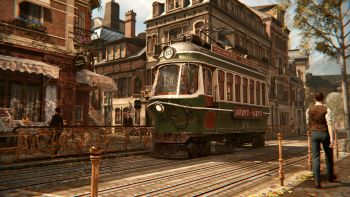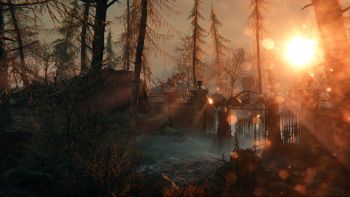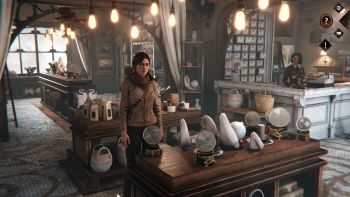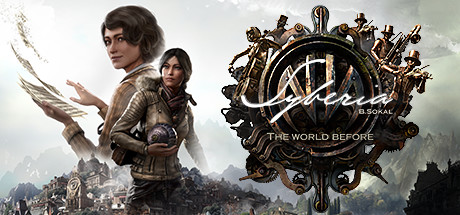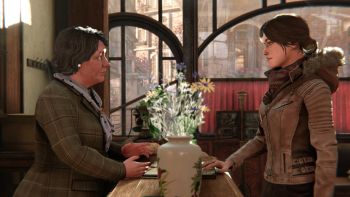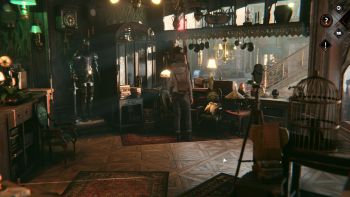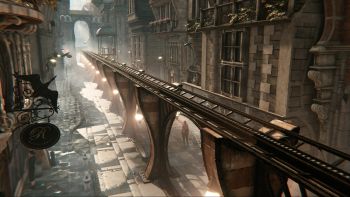|
By flotsam
Syberia: The World Before
Microids/Koala Games
In a word, marvellous.
Itís been 20 odd years or so
since we were first introduced to Kate Walker and her habit of getting
on trains and heading off to who knows where. Two adventures have
passed in between, the first as engaging and engrossing as the original
outing, the second a major disappointment. Which raised the stakes for
this chapter, one which I was both reticent and hopeful to experience.
As I said at the time, Kate deserved so much more than the last one, and
she rightfully got that with this.
We begin with Kate imprisoned
and being used as forced labour in a salt mine. Escaping is a big
thing, then the least of things as Kate seeks to keep a promise, one
that is perhaps not as exotic as finding mammoths, but is no less
momentous. What follows is a journey that flits back and forth between
various times and characters and locations, a journey in which Kate
learns so much more about herself. As always, she is in pursuit,
hunting for traces of a young woman depicted in a painting from years
ago.
The woman in question is named
Dana, a young musician whom we meet in 1937. She is on her way to the
town square of Vaghen, rewarded as the best student at the Academy that
year with the honour of playing in the town square at the spring
concert. An elaborate Ďautomatoní piano constructed by the one and only
Hans Voralberg as well as an enthusiastic crowd awaits her. What is
glorious is however a veneer, hiding the growing harassment and
persecution of Vageran people like Dana at the hands of the Brown
Shirts, and a looming war.
Across the next 15 or so hours
that it took me to play through, Danaís story is at the centre of
things. Kate is ever present, but in one sense she is Ďlivingí Danaís
life, dogging her historical footsteps and uncovering the (at times
surprising) aspects of her life. What she does with that, and what she
lets it do to her, is all up to Kate, but I thought they were equal
parts of this grand tale.
You play both of them in the
course of the game, and at times you can jump back and forth between
them, learning things in the past as Dana that you can then apply in the
present with Kate. This aspect of the puzzling was particularly
enjoyable, and was not limited to the two of them. Kate still carries
the heart (and soul) of Oscar, her automaton companion from earlier
games, and finding it another host will enable Oscar to both be present
and utilised in helpful ways.
The construction of the game
world is engrossingly exciting. Visual realism abounds, from the
textures, the shading, the design, to the movement and mannerisms of the
characters, and everything in between. Every little detail is richly
conceived, and without wanting to gush, itís way more than eye candy;
rather, itís a living, breathing environment that is just a joy to be
in. I am the first to concede that adventure games donít need this
degree of meticulous design to be enjoyable, but give me something like
this any day.
Needless to say, the sound is
equally impressive, both the ambient as well as the score. It is an
equal participant in the creation of that living world, and importantly
for mine, the game knows when to utilise music and when to leave it
alone. Music is often overdone, and I appreciate it when it isnít.
Here it tends to be most prevalent in the cutscenes that feature
throughout (or maybe thatís when I tended to notice it most), which
suits and accentuates their cinematic feel.
Moving around this enticing 3D
world is done in the third person via point and click, and while I would
have preferred the free movement of WASD and the mouse to steer, if you
click and then hold the mouse, Kate or Dana or whoever will follow where
the mouse cursor goes. Which was a happy half-way house.
The perspective is dynamic, the
camera out of your control, so the environment passes by and around you
as the character walks around. The camera isnít a passive over the
shoulder view, but moves about, punctuated by short cutscene sequences.
While there were a few occasions when I wanted my view to be from
somewhere else (the cemetery later in the game stands out), on the whole
it was impressively managed.
Everything is voiced and
appropriately lip-synched, and again it is top-notch. Kate returns,
Dana is equally as strong, and I canít think of a weak one. Mr Ludwig
was particularly impressive; you can find out why for yourself.
Interacting with the game world
is all done with the mouse, and hotspots and cursors will indicate where
and what you can do (look, take, talk etc). If you get the Ďuseí
option, a little visual menu will pop up from which you can cycle
through your inventory items to choose the one to use. You can though
access and look at (and importantly manipulate) items in your inventory
independently.
I did think though that some
aspects of the interaction were fiddlier than they needed to be.
Conversation options pop up, whereupon you need to click and then drag
the cursor to your chosen option, and the same thing happens with other
action options (look or use for instance). As well, some actions are
mimicked with the mouse (pull open a draw, turn a key, pull a lever,
slide a door etc) and I have never found this to make things more
immersive. It also wasnít always clear at times what I was supposed to
do, although as the game progressed that became less of an issue. In
the scheme of things, they were very small issues.
Puzzling is largely about
finding and using things and manipulating other things. Some of the
ones I enjoyed the most were among the latter; restoring the Voralberg
piano in Kateís time was an example. There were a couple involving
interpreting material and documents, and all of them had hints available
should you need them. I doubt you will get stuck, but you will no doubt
need to do some fiddling.
With quite a few puzzles you
will be drawn into a close up, in which you then have complete control
over the camera. This will enable you to examine the puzzle (a machine
for example) for every angle, finding all the relevant places of
interest and inspection. So too with inventory items, which you can
turn through a complete 360 degrees, identifying how they might be
manipulated in order to be properly used.
Top right in the game window are
two icons, the menu and a diary that documents your journey and keeps
tabs on things (including your inventory items), for which you can turn
notifications on or off. There are two other icons you can choose to
display, one for hints and the other for your current and optional
objectives. You can ignore the latter, but achieving them will help you
further explore the various backstories and detail of the events. They
arenít onerous, and I would recommend doing them, ditto turning off
subtitles if you donít need them. You donít have to click to progress
dialogue, and letting it unfold through the characters as opposed to
being tempted to read it is the best paced way for things to move along.
In that regard, while
double-clicking will make the character run, the game is designed for
you to take your time. Quite apart from appreciating the detail, there
are times you can choose Ďintrospectioní, which lets the character
ponder and think about wherever they are at. So too when eg. travelling
on the tram you can choose when you went to continue as opposed to
having a further quieter moment looking out the window.
The game autosaves on a very
regular basis (and if you want to exit will tell you how long since the
last save) and you just pick up where you left off. You can if you wish
choose one of the previous chapter save points (there were 32 when I
finished) and start from there. Three profiles let you have three games
in progress should you need to, and you can tweak various settings at
any time.
So much of this game is an
individual treat. Certain cutscenes are worth the price of entry alone
(the wartime shoot out is one example). The sum of its parts though is
truly wonderful. I could tell you much more about it Ė the story, its
themes, the humour, and its other emotions - or you could just go play
it.
I played on:
OS: Windows 10, 64 Bit
Processor: Intel i7-9700K 3.7GHz
RAM: Corsair Dominator Platinum RGB DDR4 32GB
Video card: AMD Radeon RX 580 8192MB
GameBoomers Review Guidelines
August 2022
design copyright© 2022
GameBoomers
Group
 GB
Reviews Index GB
Reviews Index |
